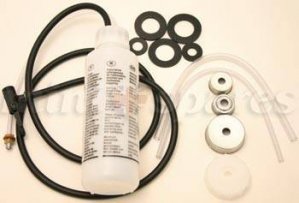Since disc brakes were new in 1967, the valve was still being worked out for the next few years. The 1967-70 valves could consist of as many as three elements and the valves would not work properly without all the pieces. Both 1967-70 factory drum and factory disc cars have (or had) a distribution block which is identical whether the car was drum or disc. Although very similar in appearance to a proportioning valve, the distribution block does not alter brake line pressure. The distribution block keeps front and rear systems separate, splits the left and right front lines and houses the sending unit for the brake failure warning light. The 1967-1970 factory disc vehicles employed an additional valve, referred to as a hold-off valve, mounted at the master cylinder. The final component in the 1967-70 factory disc brake systems was a correction valve typically located in the front to rear brake line for the rear brakes. This valve was not used in every factory disc brake car, but would make the front to rear line two pieces with the valve usually found mounted near the floor pan of the car. An original 1967-70 disc car can be factory correct without the correction valve, but not without the hold-off valve at the master cylinder.


















